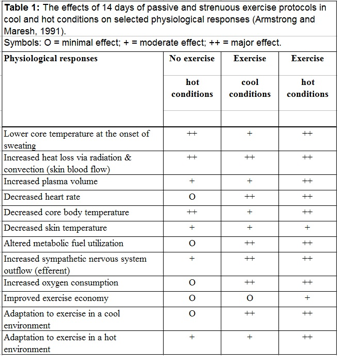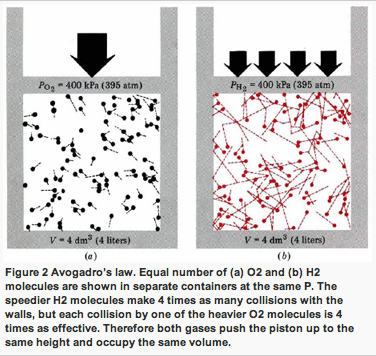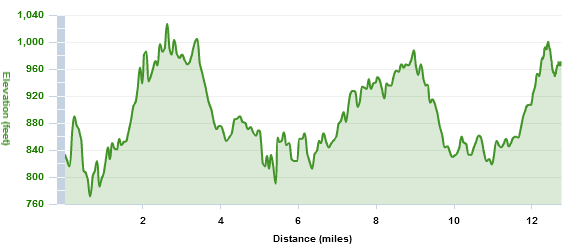Running in extreme heat
Most people are well aware of the danger that accompanies intense exercise in extreme heat. Those who fail to properly prepare for these conditions are subject to dangerous bouts of dehydration and heat sickness. However, when approached correctly, training under warm conditions has its benefits and is known as heat acclimatization training. Keep in mind that it’s not for everyone and should only be done with great caution or under supervision by a certified trainer
According to a study published by Aoyagi, McLellan, and Shephard, some of the potential benefits of heat acclimatization training include:
- Improved aerobic fitness leading to greater cardiovascular reserve
- Slower increase in body temperature
- Reduced cardiovascular stress during exercise
Reaping these benefits are not easy and hardly a guarantee. As one of our previous entries on heat acclimatization shows, your body has to work much harder to perform than it normally would. With the right precautions and gradual adaptation to training in the heat, you’ll discover that it improves your fitness far more than training under normal conditions.

Failing to Prepare is Preparing to Fail
The better you prepare yourself for running in high temperatures, the better you’ll perform. More importantly, the better you prepare, the lower your risk of dehydration and/or injury.
Mind the Heat Index – The actual temperature of the weather itself is only one component of the heat you’ll face; Humidity also plays a large part. The more humid it is, the hotter it will feel outside. Check the NOAA Heat Index to see just how hot it really is out, and consider holding off your run if the heat levels are in the danger zone.
Hydration is Critical – It’s very tough for your body to replenish fluids at the same rate it loses them during exercise, so drinking enough water before a run, especially in very warm conditions, is one of the main things that will prevent dehydration and heat exhaustion. Bring water during your run or stop by water fountains if they’re along the way. I typically take a 32 oz jug filled half with ice and half with water. The jug stays full with cold water even as the sun quickly melts the ice.
Needless to say, running long distances in extreme heat is not a good idea. If you happen to be training for a long race and it’s a very warm day, try to run in shaded areas and drink fluids with electrolytes. Consider bringing a sports drink like Gatorade or a GU product to replace some of the electrolytes you’ve lost.
What to Wear – Opt for the lightest clothing you can find, both in terms of weight and color. A black shirt will absorb a great deal of the sun’s heat, while a white one will reflect it off of you. A good pair of polarized sunglasses can also make a big difference in comfort as they neutralize the sun’s bright rays.
Be Mindful of the Signs of Heat Sickness – Dehydration can result in heat exhaustion and it can progress to a heat stroke, which is potentially life threatening.
If you start to feel weak, lightheaded, or nauseated during your run – always stop. Don’t ever risk it. Just get into a shaded area and rehydrate. Here are some additional information about preventative measures from the CDC.
Note: above image is taken from Armstrong, L.E. (1998). Heat Acclimatization. In : Encyclopedia of Sports Medicine and Science




One thing I’d recommend would be not running when it’s sunny. Here in Singapore it’s at least 82 degrees (and around 90-95% humidity) year round – those times when I’ve gone for a run in bright sunshine have been absolutely horrible and usually end up with me packing it in before I’ve run as fast as I intended, or lying on the floor for the rest of the day after I get back.
As a result, I’ve had to start all my runs before 6.30am: that way I’m usually home just as the sun comes up, or before it’s got too hot (long runs are still a struggle, but there’s the added incentive to finish earlier, so that’s a positive for my pace…).
Running early isn’t for everyone: you then have to contend with getting up earlier (which was painful for the first week or two, but then I adjusted) and also to running on an empty stomach. It definitely helps to have some sort of sports drink to chug on while you’re running – I’ve tried going without, and that was also rather unpleasant.
Same here at Virginia Beach, VA – the heat and humidity is unbearable. I start my 10+ milers just after 5:30am so I can also avoid the sun. Once the sun is up, it’s a whole different calculation and there’s no way I would finish any of my long runs. I’ve tried evening runs after the sun has set… I just never have enough energy for it. I can’t bring myself to look forward to it either. Running after work? No way. But as a way to start my day? Anytime.
I’m in Barranquilla, Colombia, and I have to admit that the heat and humidity are causing me to struggle. It’s usually around 80+ degrees when I run in the morning, with humidity around 60+ percent if I’m very lucky, much higher if not. I moved here from Miami Beach, where I trained successfully for three marathons. The few extra degrees and humidity in the temp here seem to make all the difference. I routinely have stomach trouble after long runs here, even when I start at 5:30 a.m. (a hard switch – I was naturally an evening runner) and can’t yet figure out the solution.
Hi Courtney! So I just ran a 10.5 mile trail yesterday after several days of hard rain. The standing water made it really miserable and steamier than usual. Now, I very rarely stop during my long runs, because I managed to convince myself that it defeats the purpose of a long run, but… I will say that it made a huge difference in terms of how I felt afterwards.
Try running with a camelbak (or just bring water) and take intermittent breaks every few miles to let your HR recover – it’s impossible to keep HR low on really hot and humid days, but giving it time to come back down at regular intervals makes a tremendous difference.
Take it easy and keep cool.
Wimps! I run in San Antonio in 110 degree heat and I’m fat and out of shape. No problems. Your body is strong. That said, I run 1-2 miles, lol.
I’m used to long runs. I’m back in Dubai in 110 degree heat…and it’s tough. Short runs are possible. I agree with all of the info in the article and I know first hand the signs of heat stroke. You might just think you’re out of shape, but don’t push harder. Weak legs, feel like vomiting – stop, drink, cool down.